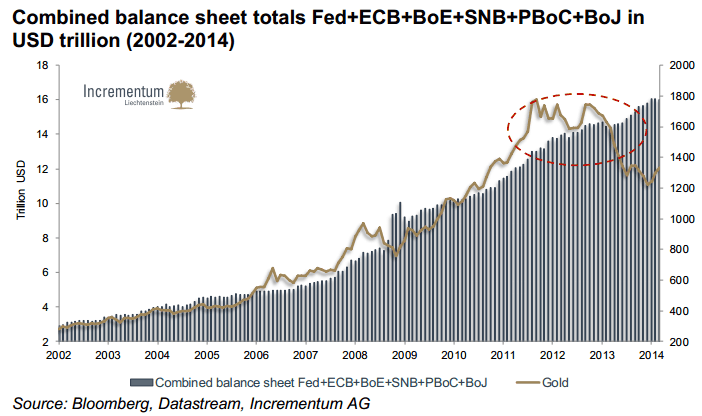My last two posts covered the investment outlooks for stocks and bonds. In short, now is not a good time to invest in either. Stocks have only been this expensive three times since 1880: 1929, 1999, and 2007, after which stocks fell 45% or more. I believe another stock crash will soon occur. It may not be as bad as a 45% drop, but it will be bad. Bonds, like stocks, are also crazy expensive. They, in fact, have never been as expensive as they are now. In both of these investments, it is possible that we could see one last bull run in the next year before things go south. But for both stocks and bonds, the risk far outweighs the potential returns at this point.
So where can you invest to actually make money? There is significant value in precious metals: gold and especially silver. Before you start thinking I’m a doomsday prophet, allow me to explain the financial reasoning for buying gold and silver. In other words, I’m not also going to recommend that you stockpile baked beans and ammo in your basement (although that might not be a bad idea either!). I believe gold and silver can make me money, and that’s why I invest in them.
There are many factors that lead me to invest in gold and silver, and the first one is very simple. You’ve heard the mantra a thousand times I’m sure: buy low and sell high. Gold and silver have been falling for the last five years, and I believe they have bottomed out. Check out the chart of silver for the last 20 years:

Link: https://www.bullionvault.com/gold-price-chart.do
As you can see, silver reached an all time high of $46.47 per ounce on March 26, 2011. In November of 2015, silver reached an astounding low of $13.88 per ounce! That’s about a 70% drop! Since then, silver has reversed its decline and has reached $17.50 per ounce. It appears $13.88 was the low for silver, and it’s now on its way back up. If you were to invest now and silver returns to its all time high, you would realize an amazing 271% return! You would almost triple your money.
So why am I focusing on silver over gold? While both would be a good investment, I believe there is much more potential to make big money in silver over gold. Let’s talk about the gold to silver ratio. Because there is 26 times more silver on Earth than gold, the price of silver should be 26 times lower than the price of silver. It’s the principle of supply and demand. While demand may be higher for gold than for silver, the price ratio should be somewhere around that level. During the Roman Empire, you would have to turn in 12 ounces of silver for 1 ounce of gold. When the US used gold and silver as currency, you would have to turn in 15 ounces of silver for 1 ounce of gold. You may be asking, “So what?” Well, at current prices, you would have to exchange 74 ounces of silver to get 1 ounce of gold! In other words, silver would have to rise to exactly $50 per ounce to achieve the 26 to 1 exchange rate. Of course, this ratio could also be achieved by a substantial fall in gold prices, but I don’t see that happening after having already experienced five years of falling. Plus there are other factors that lead me to believe that both gold and silver will be rising.
So what makes gold and silver rise? It’s actually pretty simple if you think about it. As the government continues to print money, each dollar becomes less valuable. Think of it this way. Say there are a million dollars in circulation. You have 500,000 of them and your neighbor has 500,000. So you and your neighbor each have 50% of the money supply. The government is greedy, however, and they want 1,000,000 dollars for themselves too. So they simply print off 1,000,00 more dollars. Now, there are 2,000,000 dollars in circulation, but you still have 500,000. Whereas you held 50% of the the money supply before, you now only hold 25% of the money supply. You became a lot less wealthy comparatively. How do you prevent this from happening? Simply don’t hold dollars. Instead, trade them in for something real that the government can’t print: gold or silver. As dollars become more and more worthless, your gold and silver look comparatively better, and people will be willing to pay more and more for them. Below is a chart that compares world government spending to the price of gold. Precious metals are undervalued.

Because governments will always print money, gold and silver will always rise in the long run. Therefore, I believe both gold and silver will rise. However, silver will need to rise exponentially more to achieve the gold to silver ratio of 26:1. I am not a “gold bug” who will live and die by my gold and silver. If stocks were to fall 50%, I would sell the majority of my precious metals and invest in stocks. It’s all about knowing where you can earn the most money going forward, and right now, I expect gold and especially silver to provide by far the best returns.


